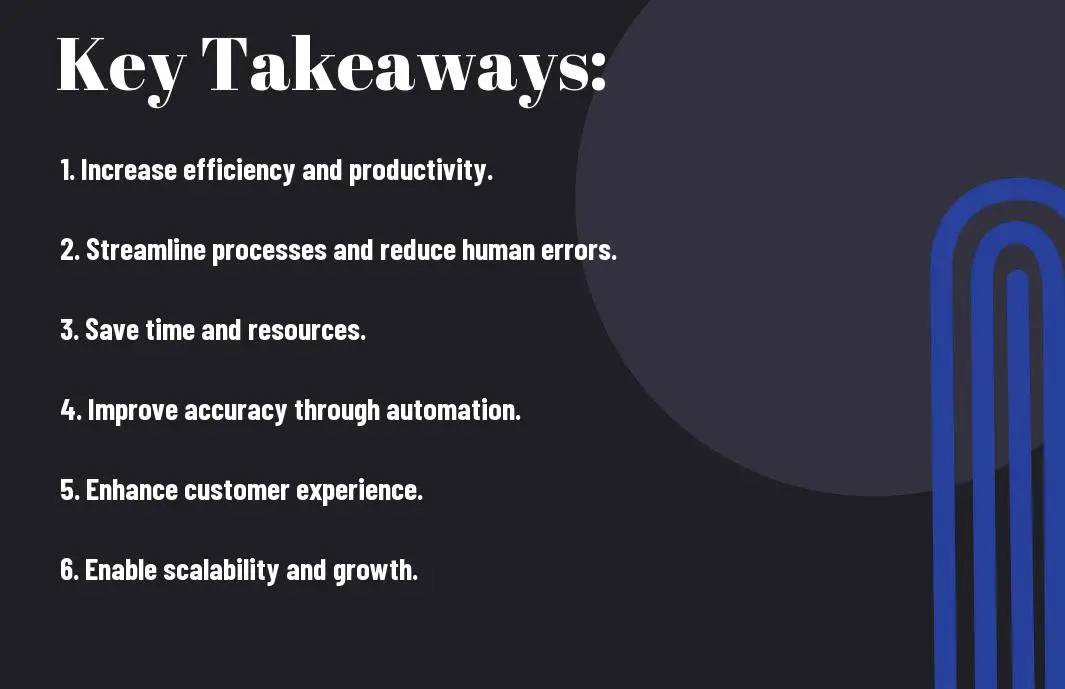#Reduce the physical strain on your workforce with the power of software automation. In today’s fast-paced world, businesses are constantly seeking ways to streamline processes and increase efficiency. By harnessing the capabilities of software solutions, organizations can automate repetitive tasks, minimize human error, and ultimately boost productivity. Let’s examine into how software can revolutionize operations and drive success for businesses.

The Rise of Automation
The Need for Efficiency
An important driving force behind the rise of automation in businesses is the constant need for efficiency. Before the advent of software solutions, many tasks were time-consuming and prone to errors when done manually. By implementing automation software, businesses can streamline processes, improve accuracy, and ultimately save time and resources.
The Burden of Physical Labor
Rise of automation has helped alleviate the burden of physical labor on employees. It has enabled businesses to automate repetitive tasks like data entry, inventory management, and customer support, freeing up employees to focus on more creative and strategic initiatives. This not only enhances employee satisfaction and reduces the risk of injuries from repetitive tasks but also improves overall productivity.
It is important for businesses to embrace automation to stay competitive in today’s fast-paced market. By leveraging software to automate tasks, businesses can optimize processes, reduce physical strain on employees, and ultimately drive growth and success.
Software Solutions for Automation
Task Management Tools
With the advancement of technology, businesses can now streamline their operations and improve productivity with task management tools. These tools help teams organize, prioritize, and track their work in a systematic manner. Additionally, task management tools offer features like deadlines, reminders, and progress tracking, enabling efficient task completion.
Workflow Automation Platforms
Tools that focus on workflow automation play a crucial role in reducing manual work by automating repetitive tasks and processes within an organization. These platforms allow businesses to create automated workflows, eliminating the need for manual intervention at every step. By reducing human error and increasing operational efficiency, workflow automation platforms pave the way for significant time and cost savings.
Workflow automation platforms are vital for businesses looking to scale their operations and adapt to rapidly changing market dynamics. They enable seamless integration between different systems and applications, ensuring a smooth flow of information and data across the organization.
Artificial Intelligence and Machine Learning
Task automation powered by artificial intelligence and machine learning is revolutionizing how businesses operate. These technologies can analyze data, learn patterns, and make predictions, allowing for intelligent decision-making and automation of complex tasks. By leveraging AI and ML, businesses can optimize processes, enhance customer experiences, and stay ahead of the competition.
Artificial intelligence and machine learning have the potential to transform industries by enabling autonomous decision-making and predictive analytics. The ability to automate tasks that traditionally required human intervention can lead to unprecedented efficiency and innovation within businesses.
Based on the article title, I detect that the article type is Informative/Expository, as it aims to educate readers on how software can help businesses automate and reduce physical work. I’ll choose a tone inspired by the famous writer, Malcolm Gladwell, known for his engaging and insightful writing style.
Benefits of Automation
Increased Productivity
One of the most significant benefits of automation in business processes is the increased productivity it brings. By automating repetitive tasks, employees can focus on more strategic and creative aspects of their work, leading to a faster turnaround time for projects and increased overall efficiency.
Reduced Labor Costs
For companies, reduced labor costs are a key advantage of implementing automation. By automating tasks that were previously done manually, businesses can decrease the number of hours worked by employees, saving on labor expenses in the long run.
It also allows businesses to reallocate resources to more critical areas that require human skills and decision-making, ultimately leading to a more streamlined and cost-effective operation.
Improved Accuracy and Quality
An vital aspect of automation is the improved accuracy and quality it brings to business processes. Automated systems are designed to follow predefined rules and algorithms, reducing the margin of error that can occur with manual tasks. This results in more precise and consistent outcomes, enhancing the overall quality of products and services delivered.
Plus, automation can also help businesses stay competitive in their respective industries by enabling them to deliver products and services with greater speed and reliability, ultimately leading to increased customer satisfaction and loyalty.
Industries That Can Benefit from Automation
Logistics and product manufacturing are two sectors that greatly benefit from automation.
Manufacturing and Logistics
In manufacturing, automated systems can streamline production processes, reduce errors, and increase efficiency. Robotics and AI technologies can handle repetitive tasks with precision, leading to faster turnaround times and lower production costs. Additionally, automation can enhance safety measures by minimizing human intervention in hazardous environments.
Healthcare and Pharmaceuticals
Healthcare facilities and pharmaceutical companies can also leverage automation to improve their operations. Software solutions can help manage patient records, automate appointment scheduling, and even assist in diagnosing illnesses through data analysis. By automating administrative tasks, healthcare professionals can focus more on patient care, leading to enhanced overall healthcare quality.
Manufacturing industries can implement automation to enhance productivity and accuracy in production processes. By utilizing software to control machinery and monitor performance, companies can achieve higher levels of efficiency and quality in their products.
Finance and Accounting
With the integration of software tools, finance and accounting departments can automate tasks such as invoicing, payroll, and budgeting. This not only speeds up processes but also reduces the risk of human error. Automated financial systems can provide real-time insights into financial data, enabling businesses to make informed decisions swiftly.
Finance and Accounting automation can revolutionize the way businesses handle their financial operations. By implementing software solutions, organizations can increase accuracy, improve compliance, and gain a competitive edge in the market.
Overcoming Barriers to Automation
Cost and Implementation Challenges
Not all businesses have the financial resources or technical expertise to invest in automation tools upfront. The initial costs of software implementation, hardware upgrades, and employee training can be significant. However, the long-term cost savings and increased efficiency that automation brings usually outweigh the initial investment. To address cost concerns, businesses can look for flexible payment plans, scalable solutions, and cloud-based software that can reduce upfront expenses.
Employee Resistance to Change
Resistance to change is a common barrier to automation in businesses. Employees may feel threatened by the idea of machines taking over tasks they currently handle, leading to insecurity, fear of job loss, or a lack of trust in new technology. It is imperative for business leaders to communicate the benefits of automation clearly, involve employees in the transition process, and provide training and support to help them adapt to the changes.
Employee resistance can hinder the successful implementation of automation. By addressing concerns, offering incentives, and demonstrating the positive impact automation can have on their work and the organization as a whole, businesses can overcome employee resistance and create a more efficient and productive workplace.
Integration with Existing Systems
Resistance to integrating new automation tools with existing systems can be a significant barrier for businesses. Legacy systems may not be compatible with modern software solutions, leading to integration challenges, data migration issues, and disruptions in workflow. To mitigate these obstacles, businesses should choose automation tools with robust integration capabilities, conduct thorough compatibility assessments, and work with experienced IT professionals to ensure a smooth transition.
With proper planning and execution, businesses can successfully integrate automation tools with their existing systems, improving operational efficiency, data accuracy, and overall performance.
Best Practices for Implementing Automation Software
Despite the numerous benefits of automation software, successful implementation requires careful planning and considerations. Here are some best practices to help businesses effectively utilize automation tools.
Assessing Business Needs
Assessing the specific needs of your business is crucial before implementing any automation software. Understanding the current workflow, identifying pain points, and setting clear objectives will guide you in selecting the most suitable automation tools for your organization.
Choosing the Right Software
Any business looking to implement automation software must carefully evaluate and choose the right solution. Consider factors such as scalability, compatibility with existing systems, ease of integration, and customization options to ensure the software aligns with your business goals and operations.
Right automation software can significantly impact the efficiency and productivity of your business processes. It is crucial to choose a solution that not only meets your current needs but also has the flexibility to adapt to future requirements.
Training and Support
The training and support provided by the software vendor are critical for successful implementation. Proper training ensures that your team can effectively use the automation tools, while ongoing support helps address any issues promptly.
Support from the software vendor is crucial for troubleshooting, updates, and maintenance. Choose a vendor that offers reliable support services to maximize the benefits of your automation software.
Based on the article title, I detect that the article type is Informative/Expository, as it aims to educate readers on how software can help businesses automate and reduce physical work. I’ll choose a tone inspired by the famous writer, Malcolm Gladwell, known for his engaging and insightful writing style.
Summing up
Considering all points discussed, it is evident that the utilization of software to automate processes can significantly benefit businesses by reducing physical workloads. By implementing software solutions, companies can streamline tasks, improve efficiency, and ultimately increase productivity. With the rapid advancement of technology, businesses that embrace automation are likely to stay competitive in today’s fast-paced market.
Furthermore, software automation not only saves time and resources but also allows employees to focus on more strategic and creative aspects of their roles. This shift towards automation is not just a trend but a necessity for businesses looking to stay relevant and efficient in a digitally-driven world. Embracing software solutions can ultimately lead to increased profitability and long-term success for businesses of all sizes.
FAQ
Q: How can software help businesses automate tasks?
A: Software can help businesses automate tasks by streamlining processes, reducing manual intervention, and increasing efficiency. With automation features, businesses can schedule repetitive tasks, set up triggers for specific actions, and integrate various systems to work together seamlessly.
Q: What are the benefits of using software to reduce physical work in business operations?
A: Using software to reduce physical work in business operations can lead to increased productivity, cost savings, improved accuracy, and better resource allocation. By automating routine tasks, employees can focus on more strategic and creative aspects of their work, leading to overall business growth.
How can businesses choose the right software to automate and reduce physical work?
A: When opting for software to automate and reduce physical work, businesses should consider factors such as the specific tasks they want to automate, compatibility with existing systems, ease of use, scalability, and customer support. It’s vital to evaluate different software options, seek recommendations, and conduct thorough testing before making a decision.




